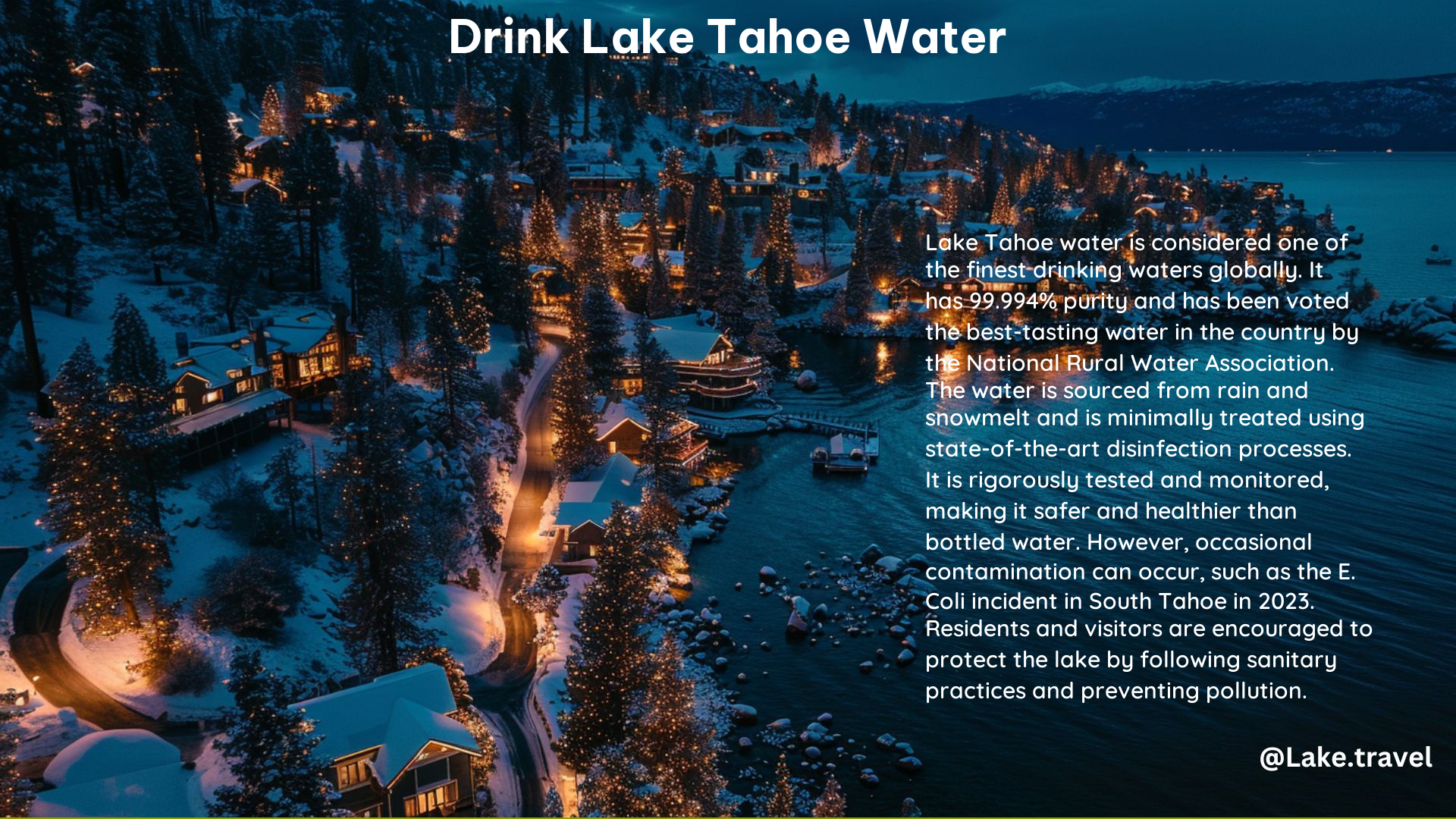Drink Lake Tahoe Water: Is it Safe?
Lake Tahoe is renowned for its crystal-clear waters, making it a popular destination for outdoor enthusiasts and nature lovers. As a lakes touring enthusiast, you may be wondering if it’s safe to drink the water from Lake Tahoe. The good news is that Lake Tahoe tap water is generally considered safe to drink, but there are some precautions to take.
Tap Water Safety

Purity
Lake Tahoe tap water has a purity level of 99.994% and is considered some of the finest drinking water in the world. The water is sourced directly from the lake, which is renowned for its exceptional clarity and low mineral content.
Treatment
The water is minimally treated using state-of-the-art disinfection processes, ensuring it meets exacting standards for safety and quality. The treatment process involves a combination of filtration, chlorination, and UV disinfection to remove any potential contaminants.
Monitoring
Municipal water systems in the Lake Tahoe region are rigorously tested and monitored to ensure the water meets or exceeds all federal and state drinking water standards. This makes tap water safer than bottled water, which is not subject to the same level of regulation and testing.
Risks and Precautions
Giardia and Cryptosporidium
These parasites can cause gastrointestinal distress and are occasionally detected in streams and other surface water sources around Lake Tahoe. However, the chances of getting sick from treated tap water are extremely rare, as the treatment process is designed to remove or inactivate these microorganisms.
Contamination
In rare cases, tap water can be contaminated, as seen in the instance of E. coli contamination in South Tahoe in 2003, where boiling tap water was advised. While such incidents are uncommon, it’s important to be aware of any local advisories or alerts regarding the safety of the water supply.
Home Water Treatment
For homes that draw water directly from the lake without proper treatment, investing in a home water treatment system is recommended. This can include filters, UV disinfection, or other technologies to ensure the water is safe for drinking and other household uses.
Initiatives and Resources
Drink Tahoe Tap
The “Drink Tahoe Tap” program is an initiative aimed at reducing single-use plastics and promoting the use of reusable water bottles and water filling stations throughout the Lake Tahoe region. This helps to support the local water supply and reduce the environmental impact of bottled water.
Tahoe Water Suppliers Association
The Tahoe Water Suppliers Association is a partnership of California and Nevada municipal water agencies dedicated to providing clean and safe drinking water to the Lake Tahoe community. They work to ensure the water supply is protected and maintained for the benefit of residents and visitors alike.
Source Water Protection
Efforts to safeguard drinking water sources from contaminants, such as proper waste management, stormwater control, and protecting the lake from pollution, are crucial for maintaining the high quality of Lake Tahoe’s water.
Additional Information
Water Quality
Lake Tahoe’s water quality is excellent, and community treatment plants are designed to remove or inactivate microorganisms, ensuring the water is safe for drinking and other uses.
Invasive Species
Preventing the spread of invasive species like Quagga Mussels and Zebra Mussels is crucial for maintaining water quality in Lake Tahoe. These species can clog water intake systems and disrupt the delicate ecosystem of the lake.
In conclusion, Lake Tahoe tap water is generally considered safe to drink, but it’s important to be aware of potential risks and take precautions to protect the water source. By understanding the safety measures in place and the resources available, lakes touring enthusiasts can confidently enjoy the pure, refreshing water of Lake Tahoe.
References:
- Tahoe Daily Tribune Staff Reports. (2003). Lake water almost good enough to drink. TahoeDailyTribune.com. https://www.tahoedailytribune.com/news/lake-water-almost-good-enough-to-drink/
- North Tahoe Business Association. (n.d.). Drink Tahoe Tap. NorthTahoeBusiness.org. https://northtahoebusiness.org/business/drink-tahoe-tap/
- Reddit. (2023). Contaminated tap water notice in South Tahoe. Reddit.com. https://www.reddit.com/r/tahoe/comments/16dncne/contaminated_tap_water_notice_in_south_tahoe/
- North Tahoe Public Utility District. (n.d.). Quality. NTPUD.org. https://ntpud.org/public-utilities/water/quality/
- Take Care Tahoe. (n.d.). Tahoe Tap. TakeCareTahoe.org. https://takecaretahoe.org/take-action/tahoe-tap/
